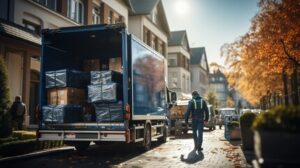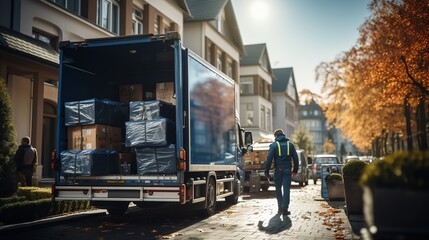Ox Movers Spring TX are transforming how people experience relocation. They no longer just carry boxes and furniture. Today’s services are centered on technology and personalization. Clients now expect moving to be stress-free and strategic.
Real-time tracking is becoming a standard in the moving process. Customers can view where their items are in transit. Mobile dashboards offer updates during every step. This gives peace of mind throughout the move.
Augmented reality is now part of move planning. Clients use apps to scan their current space. They see virtual arrangements in the new home. This makes furniture decisions easier before the truck arrives.
Digital inventories help eliminate lost items. Movers create photo logs during packing. Each box is labeled with barcodes for scanning. This speeds up both delivery and unpacking.
Some companies now use AI-powered route planning. These systems predict traffic, weather, and roadblocks. This minimizes delays and saves fuel. Efficiency and eco-awareness go hand in hand.
Customized relocation packages are trending fast. Clients choose services based on lifestyle and needs. From pet care to antique handling, options are flexible. Each move becomes more curated and personal.
Eco-friendly moving kits are replacing old cardboard. Firms provide reusable bins and biodegradable wraps. These materials protect items while reducing waste. Clients appreciate the balance of care and conscience.
Remote moving consultations have become widely adopted. Clients show their homes through video calls. Quotes and plans are created without in-person visits. This makes scheduling easier and faster.
Robotics is quietly being integrated into warehouse operations. Automated systems lift, sort, and store boxes efficiently. Fewer accidents happen and speed is increased. Movers are blending manpower with machines.
Emotional wellness is now part of premium services. Some movers offer pre-move counseling sessions. These help families, especially children, adapt mentally. Emotional support is valued alongside physical logistics.
Temporary storage pods are changing short-term relocation. These mobile units arrive on demand. They stay onsite or get picked up as needed. It’s convenient for those in transition phases.
Movers are offering unpacking design experiences. Instead of random placement, items follow a plan. Interior layouts are executed by trained staff. This turns chaos into comfort from day one.
Digital contracts are now the norm for most clients. Paperless systems speed up approval and updates. Every document is secured through encrypted platforms. Trust is maintained from booking to delivery.
Data-driven reviews guide better mover-client matches. Platforms collect feedback beyond five-star ratings. Specific performance areas are scored and visible. Clients make informed choices with clarity.
Smart trolleys are helping reduce worker fatigue. These powered carts adjust speed based on terrain. Heavy items glide smoothly through narrow spaces. Safety and comfort are maximized for movers.
Zero-contact policies are still preferred by many clients. Movers wear PPE and sanitize during the process. Payments and confirmations are done digitally. Hygiene is now part of brand identity.
Some services now include move-day virtual support. Agents remain online during the move. Clients ask questions or request changes instantly. This reduces confusion and improves coordination.
Customized handling for sensitive equipment is gaining demand. Clients with musical instruments or lab tools require special care. Movers use shock-resistant packaging and climate control. Specialized knowledge builds trust in niche segments.
Seasonal moving plans are now offered to reduce pricing spikes. Clients choose flexible windows to move. In return, they get discounted rates and faster scheduling. This balances company workflow with client savings.
Lifestyle-based packaging is becoming more common. Boxes are organized by morning routine, work-from-home, or hobbies. This speeds up adjustment in the new space. Unpacking becomes functional instead of random.
Blockchain is now used in long-distance inventory logging. Each item’s location and condition are time-stamped. Transparency improves insurance claims and loss prevention. Clients feel secure with verifiable movement history.
Cloud-based customer service centers are available 24/7. These handle bookings, updates, and inquiries in real-time. Language translation and accessibility tools are built-in. Clients across demographics are served better.
Pet relocation services have been elevated too. Movers offer climate-controlled cabins and supervised stops. Pet behaviorists help manage transition anxiety. Animals arrive calm and cared for.
Luxury moving now includes personal concierge services. Clients receive assistants who handle errands and coordination. From utilities to address changes, every detail is covered. It feels more like travel than a stressful task.
AI-driven cost simulations help predict full expenses. Users input variables into a system. The result is a near-exact cost breakdown. Budgeting becomes precise and free from surprise fees.
Green certifications now influence mover selection. Firms must prove low emissions and waste practices. Clients consider this as a decision factor. Sustainability has become part of service quality.
Gamified packing tips are being introduced through apps. Clients earn badges for efficient organization. These mini-games teach best practices while entertaining. Stress becomes fun with small wins.
Wearable tech is assisting moving crew management. Wristbands track health, location, and fatigue levels. Supervisors adjust tasks based on real-time data. Injuries are minimized and productivity optimized.
Corporate movers now provide transition workshops. Employees learn about new environments before the move. Workshops include cultural orientation and local guidance. This increases satisfaction and reduces turnover.
Reconfigurable moving trucks are reshaping logistics. Shelves and racks adjust based on cargo size. This maximizes truck space and prevents item shifts. Damage rates go down significantly.
Emergency move services have evolved past just speed. Crews now respond with pre-packed kits and digital support. Clients can relocate within hours if needed. It’s ideal for crisis or safety-related transfers.
Subscription-based moving plans are being tested. Clients pay monthly and get relocation perks when needed. It suits mobile workers and frequent movers. Flexibility becomes part of the service model.
Home staging as part of the packing process is rising. Movers collaborate with designers to enhance space. This helps sellers get better offers fast. The move-out becomes a marketing move-in.
Companies are piloting emotion-sensing tools during the move. These tools track voice tone and body language. When stress is detected, support options are offered. Mental well-being is prioritized through tech cues.
3D scanning of furniture helps plan the perfect fit. Movers upload scans into layout software. They preview placement options before the truck leaves. Time is saved and returns are avoided.
Digital locks on moving containers are now common. Access is granted via mobile codes or biometrics. This prevents tampering and improves accountability. Clients track who opens what and when.
Movers are also partnering with disposal services. Old items are sorted for donation, recycling, or resale. This reduces clutter and adds social value. The move becomes an opportunity for giving back.
Ergonomic packaging tools help movers stay injury-free. Devices assist in lifting, sealing, and wrapping. These tools improve performance and health. Staff retention benefits from improved work conditions.
Some apps now suggest move dates based on algorithms. Factors like weather, demand, and local events are considered. Clients receive optimized timing suggestions. Planning becomes smarter and more data-informed.
Hyperlocal micro-hubs are being used for last-mile delivery. Small storage centers are spread across neighborhoods. Items arrive faster and with fewer delays. Urban logistics improve through decentralization.
Clients can now subscribe to after-move support services. These include maintenance, cleaning, and furniture assembly. The home is livable from day one. The value continues beyond delivery.
Online reputation is being managed proactively. Movers request client feedback through short video clips. These are used to showcase real stories. Authenticity builds stronger brand presence.
Climate-adaptive materials are used in packing during long transits. Insulated wraps react to cold or heat. Fragile items arrive unaffected by extreme conditions. It’s a solution for global and cross-border moves.
Emotional mapping is now used in designing move workflows. Stress points are charted in the customer journey. Processes are improved based on these insights. Every step becomes more comforting and less chaotic.
Some firms offer unpacking playlists to set the mood. Clients choose music genres or energy levels. Speakers play while movers work. This adds a personal touch to an otherwise busy day.
Voice-controlled inventory systems are emerging in warehouses. Workers speak item names and quantities aloud. Systems record and confirm instantly. Accuracy and speed rise without typing or scanning.
Virtual reality tours of destination spaces are included in packages. Clients explore their future homes beforehand. They decide where everything will go. Confidence and excitement replace uncertainty.
Seasoned movers also offer mentorship to new clients. First-time movers receive planning guidance and emotional support. They avoid mistakes and feel more prepared. Experience is shared as a professional courtesy.
Biometric access on moving day adds another layer of security. Only verified identities can access trucks or pods. This reduces theft and misplaced accountability. Trust is reinforced with tech-driven control.
The industry is gradually adopting carbon credits. Companies offset their emissions by investing in clean energy. Clients are given receipts of their eco-contribution. It’s logistics with a conscience.
Digital storytelling of moving experiences is being monetized. Clients share their journey online and earn discounts. Movers gain organic promotion in return. Social media becomes a moving partner.
Precision moving is now offered for tech-heavy homes. Equipment like servers and gaming setups get special treatment. Movers label cables and photograph connections. Everything is reassembled exactly as it was.
As the future of moving continues to evolve, innovation remains the driving force. Movers are no longer just transport providers. They’re becoming transition partners with heart and vision. A seamless, secure, and smart move is no longer a luxury—it’s an expectation.

